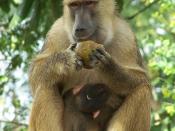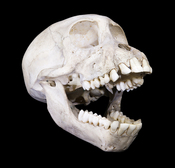General Characteristics of Class Mammalia
Mammals are the most evolved and adapted of the five Chordate classes. They include around 5000 species placed in around 26 different orders. Mammals are divided into 3 different major groups according to their embryonic development. Monotremes, although there are only 3 known living species (e.g. the platypus), are ovoviparous, but still suckle their young from simple mammory glands. Marsupials, give birth to tiny embryos which attach to the mothers nipple in the marsupium (e.g. the kangaroo) .Lastly, Placentals, give birth to young which are almost ready to survive on their own and are suckled until they leave the parent (e.g. the Yellow baboon).
In mammals, the middle ear bones, namely the malleus, incus and stapes, help transform the vibration of sound into a nervous stimuli, thus increasing the level and accuracy in hearing different sounds. Mammals are the only Chordate class which have this feature.
Mammals have hair or pelage on the external dermal surface which is made up of a protein called keratin. This hair serves a range of functions, which includes the reduction of the exchange of heat with the environment and protects the animal against its harsh surroundings like sunrays. They can also have a sensory function as in the whiskers on a cat. The hairs also help the animal camouflage (e.g. the leopard) or to reveal warning signs like the skunk's noticeable colour pattern serves as a warning to potential predators. The patterns on the hair can also differentiate young from adults (e.g. the Dalmatian dog). Mammals may also puff out their fur, making them seem larger and more intimidating to predators.
All mammals suckle their newborn young with milk which is rich in fats and proteins and antibodies which help the young face the world. This milk is produced...


